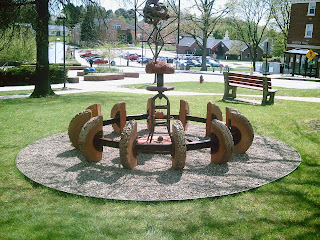Slippery Rock University announced at 2 p.m. on Apr. 29 in the James C. Myford Sculpture building that it bought a $15,000 sculpture.
It was the last day of the Kaleidoscope Festival, and Dr. Curry, acting president, spoke at the James C. Myford Sculpture Invitational.
“It is a great pleasure to be here,” Curry said.
The winner of the inaugural James C. Myford Sculpture Invitational was James Shipman. The piece was called,“Space, Time, Dream Hard.” It is a permanent collection.
“We appreciate to have this dynamic piece on campus,” Curry said.
James C. Myford Sculpture Invitational 2012
The exhibition idea came from former president Bob Smith two years ago. Smith asked Myford to start this project and Myford was willing to complete it.
“I spend months in Arizona working on my own projects," Myford said. "I told him that it was highly unlikely, but I’ll do it.”
Video: Myford's favorite project
Myford's vision was to become involved in art. His high school art teacher, Mr. Salisbury, took a sick day to take Myford to Edinburo University to meet the faculty. It was the only school that he applied to.
Video: Myford's future projects
Google Map: A walking tour of the sculptures on campus
View James C. Myford Sculpture Invitational 2012 in a larger map
Dr. Thomas Como, an art professor, met with the facility department and art students to put concrete in to hold up the sculptures.
“I thank Curry to keep this moving forward,” Como said.
At the presentation, Brunken gave a history lesson. He started teaching at SRU when Myford started. There was one problem. There was no sculpture studio. It started in the basement of Carruth Rizzo Hall. It started small. When more students were added, they needed more space. It started because someone took the inititiative to get it started. Almost 150 were in the major now.
“Every department experiences change,” Brunken said. “Jim’s hardwork comes a long way. I congratulate this building in his name.”
Josh Young, justice building and Board of Trustees declared the building's new name. After some more recognitions, people went outside to get catered food.
During the walking tour, Artist D.W. Martin explained how he made his new pieces of artwork. His artwork "Mega Hertz" was located near Maltby. He teaches sculpture and 3D design at Edinboro University.
Myford grew up in Trentum near a prosperous town with the steel mills and the glass company. Most towns were near the river. In the second and third grade, his teachers would ask him to help put bulletin boards up. He got a job helping stores by drawing the theme of the month on their store window. In junior high school, he worked with plaster and clay material.
“I didn’t use these materials in elementary school,” Myford said. “I like using the materials to make three dimensional things.”
In high school, he would make wood carvings by using gouges and a mallet. He took painting, sculpture, and ceramics. Photo wasn’t art at the time. He had a field trip to the Carnegie Museum. It was the first time he went in a museum and a gallery.
“I remember saying to myself when I went into the galler that I like this kind of thing,” Myford said. “The gallery was roomy, clean and organized.
His high school teacher, Mr. Salisbury, got Myford a job at super market. He would paint the week’s special. It would be a 4 feet by 6 feet sign outside of the store. He was making $10 dollars a week. He graduated in Trentum High School in 1958. He played football. He was the linebacker.
At his senior year in high school, his professor asked him what he wanted to do. He was a sign painter outside of Pittsburgh. He asked him to work form in him. In the summer in Pennsylvania and Florida in the winter. He was painting signs. At 18 years old, he didn’t want to go to Florida. One day, Salisbury took a sick day to take Myford to Edinborough to visit the campus. It was the only university that he applied to. He did one year of football in Edinboro. He wan’t serious about his work. He got a $500 dollar scholarship from the teacher association from Trentum high school. He studied art education. He worked 29 years at SRU and retired. He did shows in Chicago and Toronto. Currently, he works in Arizona.
“It was a pleasure to work at SRU," Myford said. "I really like teaching."
Check out a D.W. Martin video on: http://youtu.be/lwMtiPk15mo



